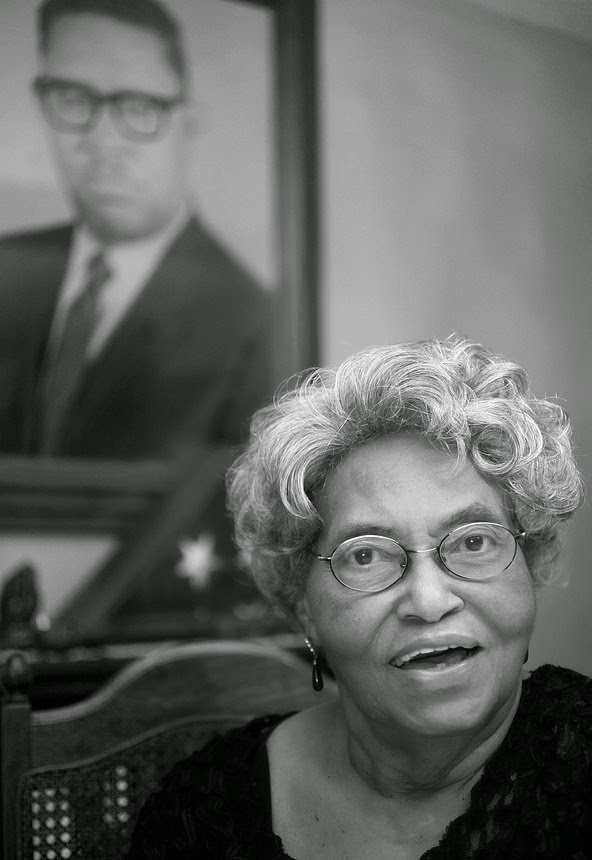
Oxford, MS-based photographer Alysia Burton Steele is having an exceptional 2014, getting wide recognition for her splendid portfolio of images entitled Jewels in the Delta.
Steele's work has been featured in the New York Times, on the news and culture blog The Root, on Jean Nash Johnson's blog eRace your isms, and in Southern Living.
This attention is well-earned, well-deserved. Jewels in the Delta is an extraordinary accomplishment, well worthy of our attention.
Steele is a professor of photojournalism at the University of Mississippi, and has wide experience as a photojournalist and photo editor. She was part of the photojournalism team at the Dallas Morning News that was awarded a Pulitzer Prize in 2006 for coverage of Hurricane Katrina.
Now that she has joined the academy, her own photography has taken a distinctively personal turn, creating documentary work characterized by a deep engagement with her subjects and a desire to learn through them and their stories something of Steele's own history.
Steele grew up in Pennsylvania, reared from the age of 3 by her grandmother, a native of South Carolina. Steele's grandmother died before Steele was old enough and had acquired the perspective needed to make sense of her grandmother's experience and to understand what it might tell her about her heritage as a child of Southern background.
By moving to Oxford, Mississippi, Steele found herself living next door to the Delta, that part of the South some call the "most Southern place on earth."
The people Steele has gotten to know, in working on Jewels in the Delta, are the church mothers of black Baptist congregations in the Delta, over 50 of them, who have shared their stories with Steele while she made their portraits.
Church mothers, I learn from Steele's project, are leaders in their church communities, recognized for their skills in organizing programs, providing comfort and support to those in need, helping preserve traditions, and inspiring young women in their communities.
Jean Nash Johnson, in her profile of Steele, describes how she is able to capture in this work these women's "directness, fortitude, beauty, and sense of their place in history."
In Jewels in the Delta, Steele finds a way to do a number of things simultaneously -- to bring us beautifully seen images but also to bring to our attention a remarkable group of people and to understand through them at least something of her grandmother's generation and the role of women in Southern religious culture.
Their legacy turns out to be a Southern legacy, a legacy Steele herself shares
with her grandmother as Southerners,
whether by birth or by adoption.
As Steele says, "These stories are important because they are stories about love, loss, education, voting rights, sharecropping, raising children and everything else that comes from living in the Jim Crow era."
"I call them "Jewels in the Delta," says Steele, "because that's what they are. The backbone to their communities, the matriarch of their families, an under-represented group of people in mainstream media. They are church mothers and they matter."
Part of Steele's project includes recording the voices of her subjects. One goal of her work is to provide a venue for the voices as well as the images. For the flavor of those voices. watch the video, imbedded below.
In this body of work, Steele joins Kathleen Robbins, Roger May, and a number of other Southern photographers working today in making their work both aesthetically compelling and personally engaged, at the deepest level.
The level of personal engagement here brings a number of riches to the work.
Lots of fine art photography today starts with ideas, with concepts. One might decide the concept was to document crossroads, or intersections, and then go out to photograph a lot of crossroads.
Sometimes this produces compelling work; sometimes it produces a set of banal illustrations of the idea.
I once saw a set of images that showed lots of blackness, with the occasional white mark. They turned out to be photographs of road surfaces where terrible accidents had happened.
These images, when experienced after one knew the idea, were sort of engaging. I thought, terrible things happen in the most ordinary of places. But without the idea, they were just images of one damn piece of road after another.
In Steele's work, the concept, or the unifying idea, is not an abstract concept, but in Steele's engagement with the people who tell their stories and share their worlds, and help the photographer find her way.
Also, lots of folks photograph in the Mississippi Delta, and for lots of good reasons. I think many of the photographs they take are fine photographs, and I would not be without them.
But many of the photographs of the Delta I have seen were made by people who flew in, made their work, and flew out. They are photographs of the Delta as that strange, exotic, other place. They were made to be shown to people who shared with the photographer a place and a view of the world significantly different from the world of the Delta.
For folks like Robbins and Steele, their work in the Delta is about finding what it means to be home, to be who you are in your own skin and in your own place, living with the South's painful and conflicted history, and getting on with your life.
Those are distinctively Southern concerns. Photographers who engage those concerns help us find our way.
You will find more on Alysia Steele here.
Steele will be publishing a book of her images, and of the voices of her fellow Mississippians. I look forward its publication with great anticipation.








No comments:
Post a Comment